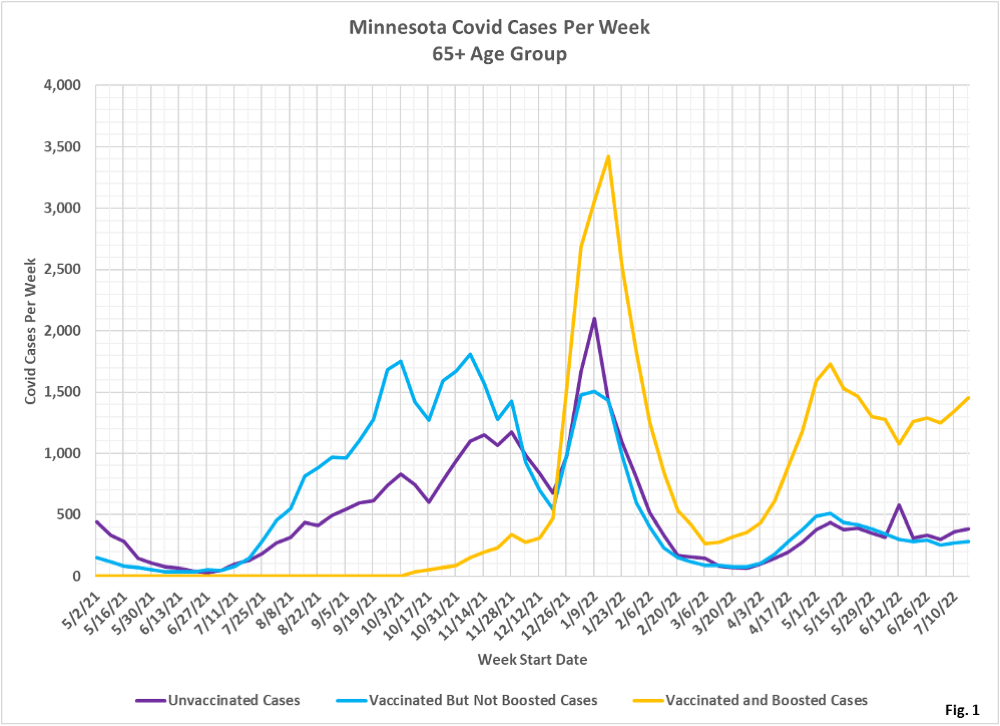

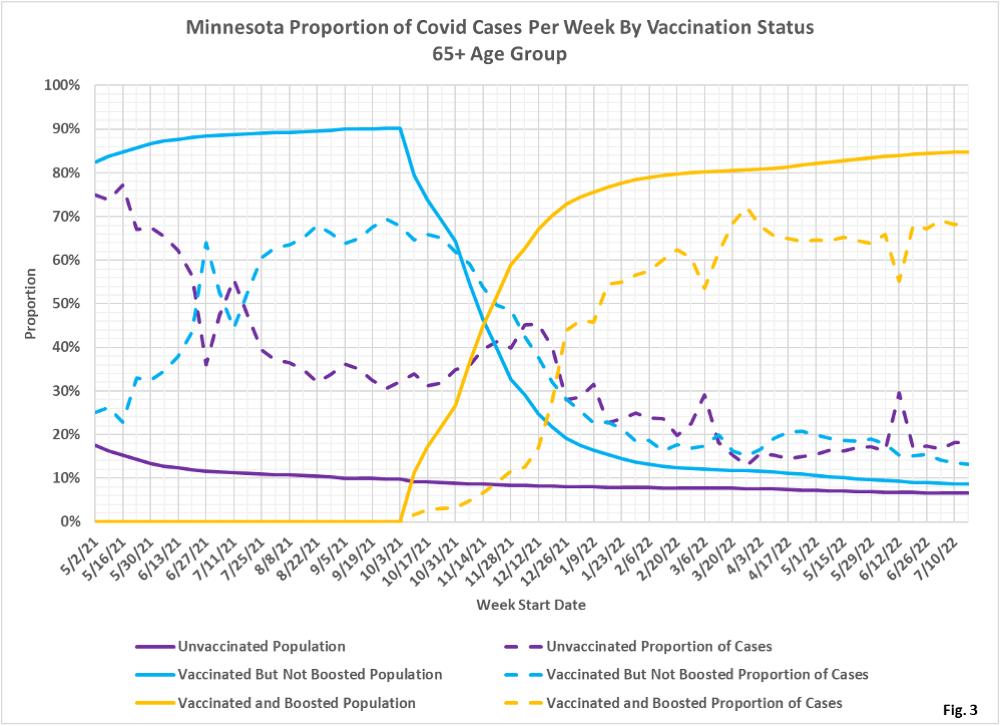
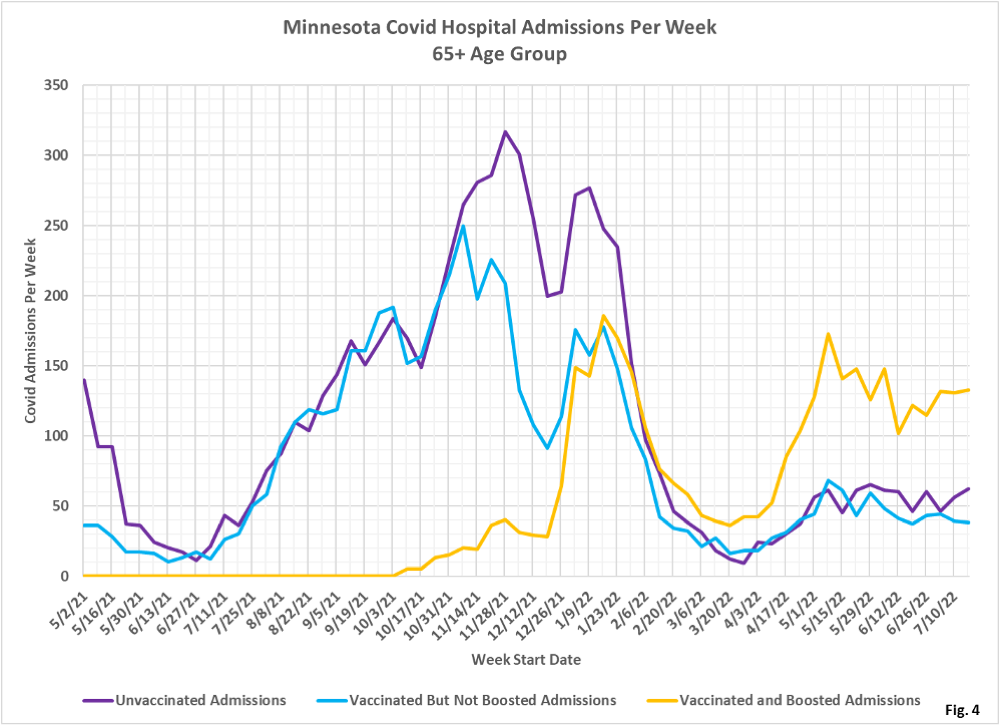
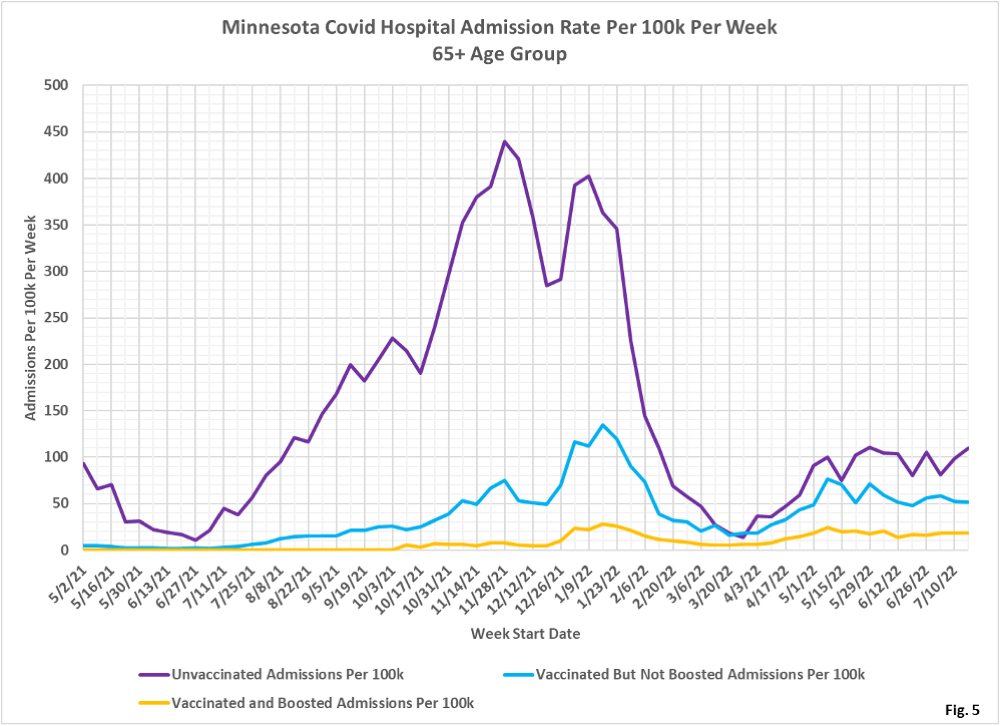
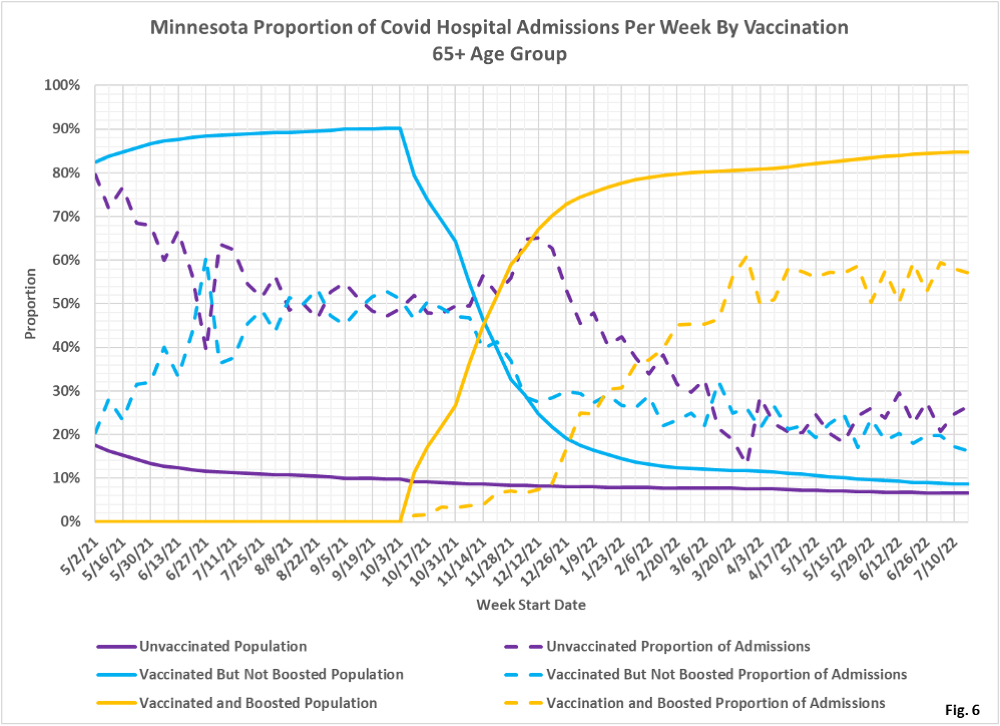
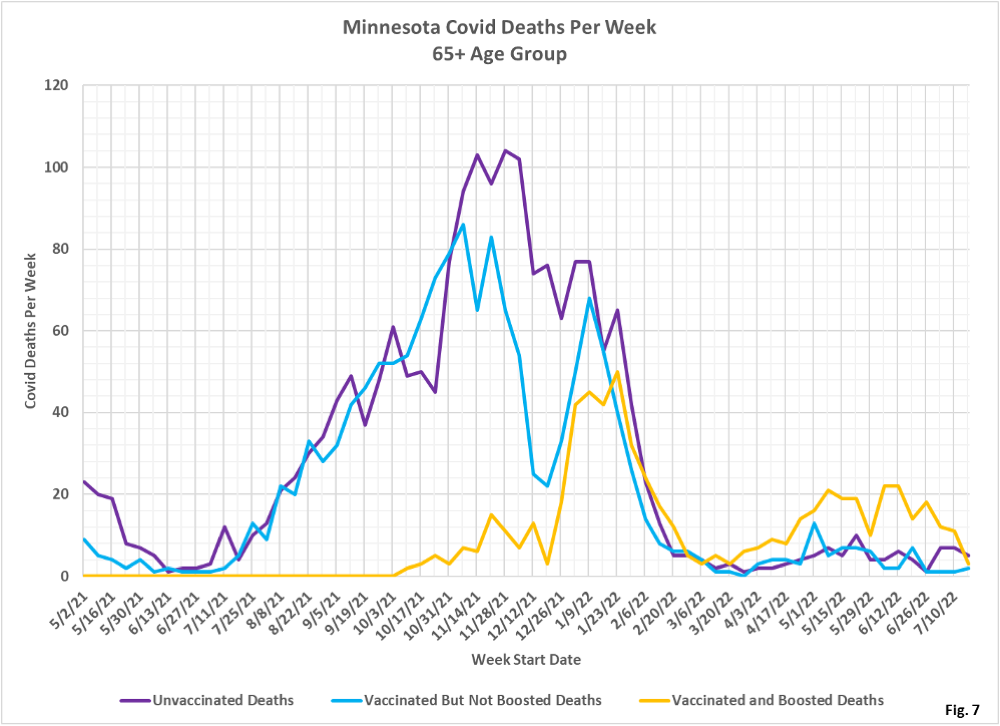
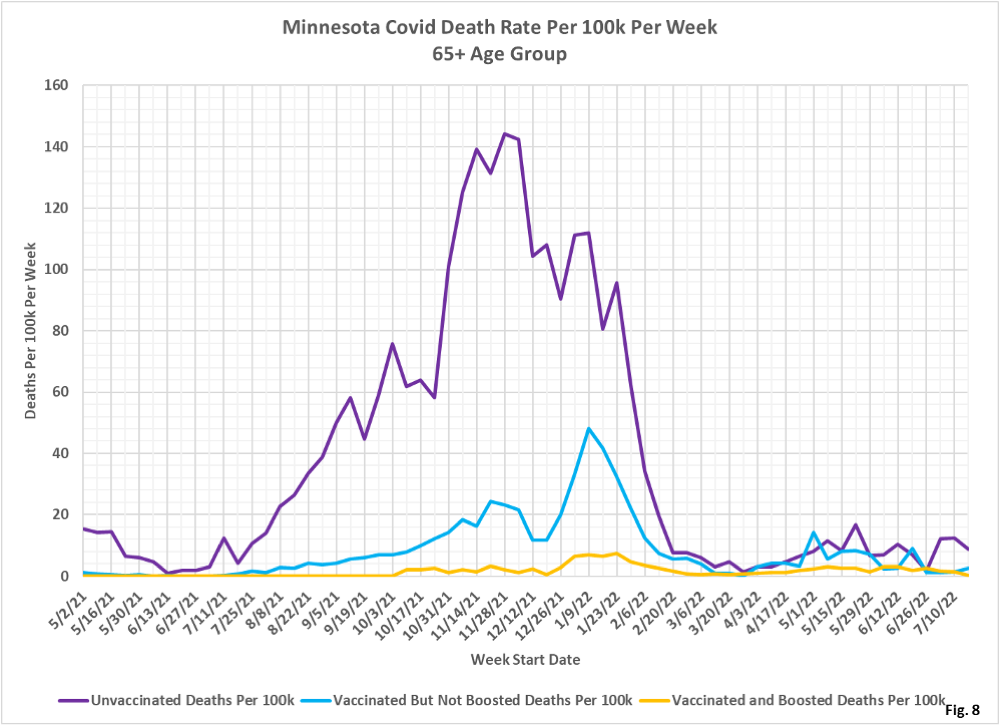
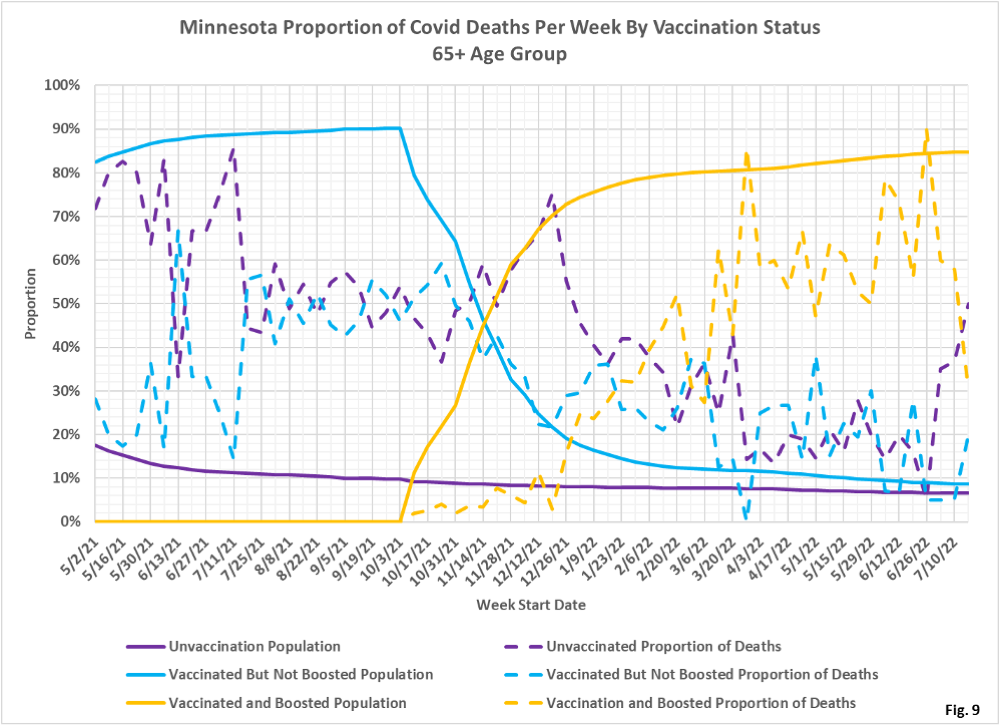 Dave’s notes:
Dave’s notes:
- The following charts illustrate that for the 65 and over age group the vaccinated and boosted subgroup does appear to have a lower risk of an individual testing positive, being hospitalized, or dying from Covid. In addition, the Vaccinated but not Boosted subgroup has lower rates of positive cases, hospital admissions, and deaths than the unvaccinated subgroup.
- This post is an update to the chart set for the 65 and older age group most recently published on 7/25/2022 here: https://healthy-skeptic.com/
2022/07/25/breakthrough- events-july-21-ages-65-and- over/. - There are 9 charts in this set, 3 charts each for cases, hospital admissions, and deaths. Each set of 3 charts consists of the actual events per week (cases, admissions, or deaths); the rate per 100k each week, and the proportion of events compared to the proportion of the vaccinated population.
- Fig. 1: This chart plots the cases in the 65 and over age group per week among the unvaccinated, vaccinated but not boosted, and vaccinated and boosted populations each week. Since the week of 12/26/2021 there have been significantly more cases each week among the boosted, rather than among the vaccinated but not boosted, or unvaccinated. However, this is not too surprising since a very large proportion of the 65+ age group is boosted (as will be seen in Fig. 3). We continue to note what appears to be a data anomaly the week of 6/12/2022, which has the appearance of MDH failing to detect approximately 200 cases among the boosted, counting them mistakenly among the unvaccinated.
- Fig. 2: This chart displays the case rates per 100k for each subgroup in the 65+ age group. Consistently through the pandemic the unvaccinated have the highest rate of cases per 100k, with the boosted having the lowest rates of cases per 100k. This data supports the idea the vaccination reduces the risk of testing positive, and that being boosted offers an additional level of protection. Note that the apparent 6/12/2022 data anomaly has a large effect on the relatively small unvaccinated population. For the past 2 weeks the case rates for all 3 subgroups have risen.
- Fig. 3: This chart displays the proportion of the 65 and over population who are unvaccinated (solid purple), vaccinated but not boosted (solid blue), and vaccinated and boosted (solid gold). For each population group we also display the proportion of cases each week (dashed lines of same color). Note that as people are boosted they are moved from the vaccinated subgroup to the boosted subgroup. Note also that over 80% of this age group is boosted, which is why looking at the rate of cases per 100k is the most accurate way of assessing risk, rather than looking at the actual numbers of cases. The way to interpret this chart is to compare the proportion of breakthroughs to the proportion of vaccinations for each group. Whenever the dashed breakthrough proportion line is below the solid vaccination line of the same color, then that category is underrepresented for population, and vaccination might be said to be beneficial (ignoring for now other confounding factors). For the week of 7/17/2022, 85% of this age group was vaccinated and boosted (solid gold line) while this group accounted for only 69% of the cases (dashed gold line). We would interpret this to show that being boosted did indeed reduce an individual’s chances of testing positive for Covid for that week. The unvaccinated, for the week of 7/17/2022, made up 7% of the population but accounted for 18% of the cases.
- Fig. 4-6: These charts display the hospital admissions, hospital admission rates per 100k, and hospital admissions proportions for the 65+ age group, in an identical format to the case charts in Fig. 1 through Fig. 3. Similar to cases, the boosted have a majority of the admissions in recent months (Fig. 4), however the admissions per 100k for the unvaccinated are consistently highest, with the vaccinated being second highest, and the boosted having the lowest rates of admissions (Fig. 5). Fig. 6 shows that admissions among the unvaccinated have been disproportionately high throughout the pandemic. For the week of 7/17/2022 the unvaccinated made up 7% of the age group population but accounted for 27% of the age group admissions, while the boosted made up 85% of the population but accounted for only 57% of the admissions.
- Fig. 7-9: These charts display the deaths, deaths rates per 100k, and deaths proportions for the 65+ age group, in an identical format to the case charts in Fig. 1 through Fig. 3. Similar to cases, the boosted have had the greatest number of deaths each week in the past 2 months before falling to only 3 deaths the week of 7/17/2022 (Fig. 7). Fig. 8 shows that the boosted subgroup has had consistently lower rates of death per 100k, despite accounting for the highest number of deaths in recent months. Fig. 9 shows that deaths proportions are highly variable, but the unvaccinated have the highest risk of death (7% of the population but accounting for 50% of the deaths for the week of 7/17/2022)
- All data is obtained from the Minnesota Department of Health (MDH) Vaccine Breakthrough Weekly Update web site https://www.health.state.mn.
us/diseases/coronavirus/stats/ vbt.html. A data file on this site, vbtadultcirates.xlsx, contains all of the age group data. - MDH defines the fully vaccinated (what we have termed vaccinated but not boosted) as those who have not received a booster after completing their primary vaccination series, and had been vaccinated at least 14 days prior to testing positive.
- MDH defines the boosted as those who have received any additional vaccination shots after completing their primary vaccination series, and also received the booster at least 14 days prior to testing positive. In addition, booster doses were only counted after 8/13/2021, the date the CDC first began recommending booster shots.

 RSS - Posts
RSS - Posts